Table of Contents
Welcome to the world of a dog’s eye, a complex and intricate system that allows them to navigate the world easily. But what happens when this system is compromised, plunging them into darkness?
In this article, we will unveil the shocking link between diabetes and cataracts in dogs, shedding light on a connection many pet owners may not know about.
Imagine the eye as a delicate camera, capturing every detail of the world around them. But just like a camera lens can become clouded, so too can a dog’s eye, resulting in the formation of cataracts. And what’s even more astonishing is the role that diabetes plays in this process.
Through a scientific lens, we will explore how diabetes can lead to the development of cataracts in dogs, discussing the various types of cataracts commonly seen in diabetic canines. We will also investigate the symptoms to watch out for, as early detection is crucial for effective management.
But it doesn’t stop there. We will also uncover the emotional impact of blindness in dogs and provide practical tips for managing their new reality. By understanding the preventive measures and regular eye exams necessary for canine health, you can take proactive steps to ensure your furry friend’s well-being.
So join us as we delve into this cataracts in dogs with diabetes journey, and equip yourself with the knowledge to protect your beloved dog from the darkness of diabetes-induced cataracts.
Key Takeaways Of Cataracts In Dogs With Diabetes
- Dogs with diabetes are more susceptible to developing cataracts due to high blood sugar levels.
- Managing diabetes and maintaining stable blood sugar levels can slow down cataract progression in dogs.
- Certain dog breeds, such as Poodles and Terriers, are more prone to developing cataracts.
- Regular veterinary check-ups are important for detecting and managing cataracts and diabetes in dogs.
Overview of Diabetes Mellitus in Dogs
Diabetes affects dogs and humans. It occurs when the body doesn’t generate or utilise enough insulin. Insulin regulates blood sugar by enabling glucose into cells for energy.
Cataracts are a risk for diabetic dogs. Cataracts are a common ocular disease characterized by the clouding of the lens, leading to visual impairment and even vision loss if left untreated.
The development of cataracts in dogs with diabetes is thought to be caused by prolonged exposure to high blood sugar levels. This excess glucose can build up in the lens of the eye, causing it to become cloudy. Cataracts may start as small opacities that gradually progress to mature cataracts, impairing vision.
Fortunately, cataracts in dogs with diabetes can be treated with surgery. The success rate for cataract surgery in canine patients is high, with many dogs regaining their vision post-surgery.
Regular eye examinations are crucial for dogs with diabetes, as they can help detect the early signs of cataract development. Early intervention prevents complications such as retinal detachment and other ocular diseases.
If you notice any signs of visual impairment or suspect your dog may have cataracts, it’s important to consult with a veterinary ophthalmologist for proper diagnosis and treatment. Managing your dog’s diabetes and addressing any associated eye conditions can help maintain their overall health and quality of life.
Understanding the Anatomy of a Dog’s Eye
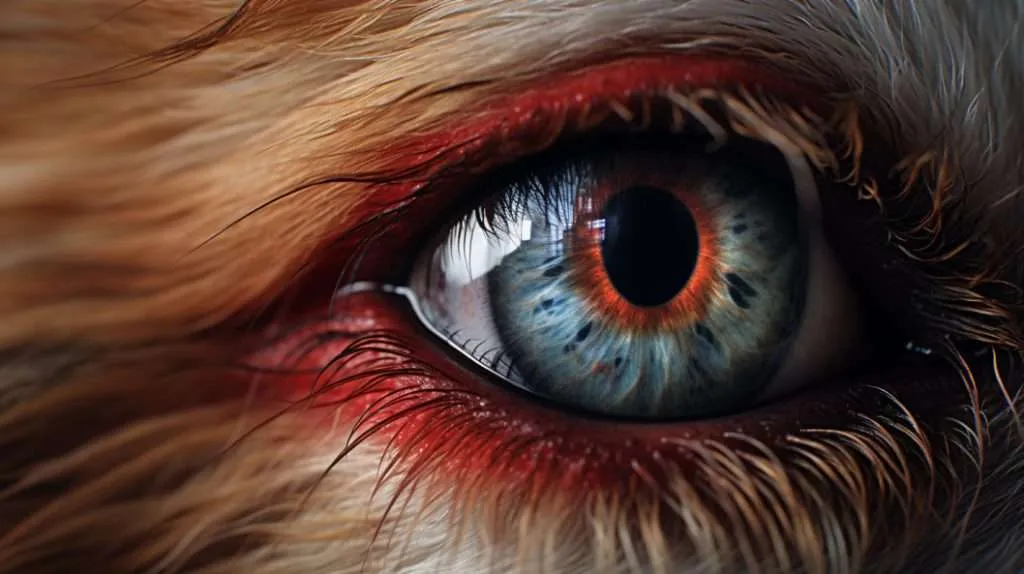
Now, imagine you’re peering into your furry friend’s eyes and discovering the intricate and delicate structure that allows them to see the world around them.
A dog’s eye is a fascinating and complex organ, similar to a human eye but with some unique differences. Like humans, dogs can suffer from various eye diseases and vision problems. Some common dog eye diseases include glaucoma, corneal ulcers, and retinal degeneration. These conditions can cause discomfort and even lead to blindness if left untreated.
Canine vision problems can range from mild to severe, affecting their ability to navigate their surroundings and interact with their environment. Understanding the anatomy of a dog’s eye is crucial in comprehending how cataracts form in dogs, which we will explore in the next section.
How Cataracts Form in Dogs
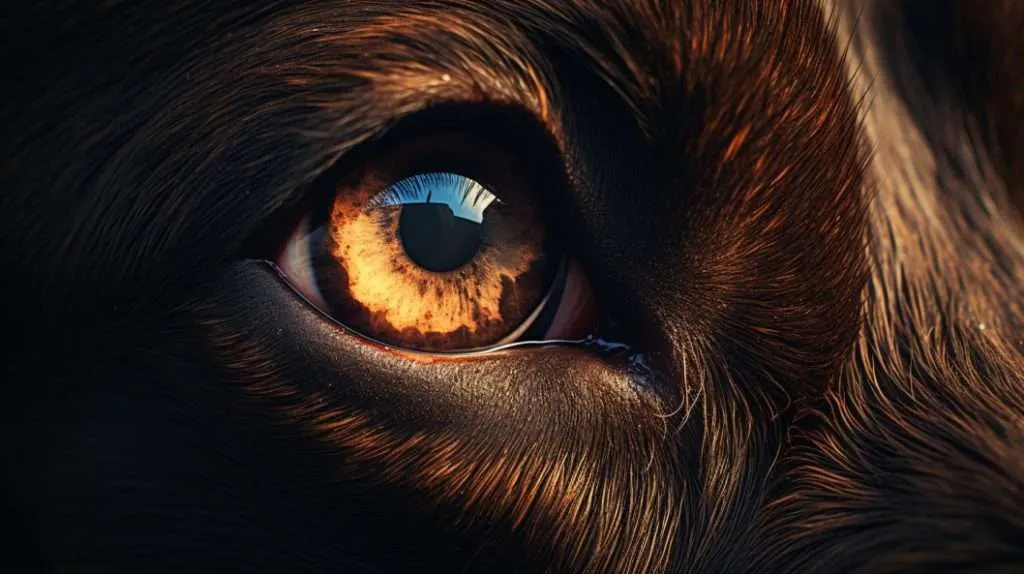
A cataract refers to the clouding of the lens in the eye, which obstructs the passage of light and impairs vision. In dogs with diabetes, cataracts are a common ocular complication. The development of cataracts in dogs with diabetes is primarily linked to high blood glucose levels, which cause changes in the lens cells. The lens becomes more opaque as the disease progresses, resulting in visual impairment and potential blindness.
Cataracts can occur at any age in dogs with diabetes, and the risk increases with the duration of the disease. Early detection and management of diabetes are crucial to help prevent or delay the onset of cataracts. Cataract surgery is often the recommended treatment for dogs with mature cataracts, and it has a high success rate in restoring vision. Regular eye examinations by a veterinary ophthalmologist are essential for dogs with diabetes to monitor for cataract development and other potential ocular diseases.
The Role of Diabetes in Cataract Development
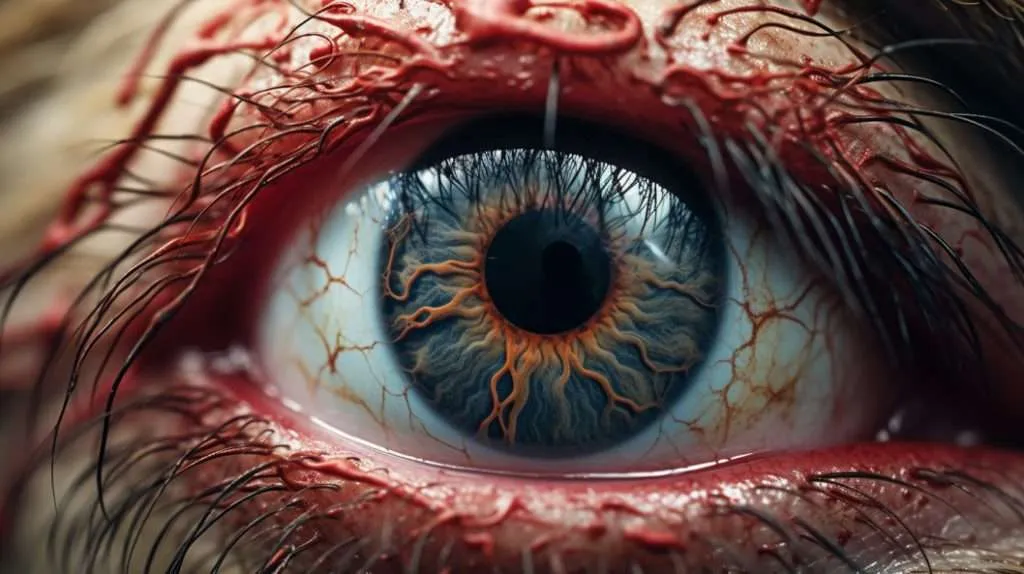
Diabetes can act as a dark cloud, obscuring your dog’s vision and leading to the development of cataracts. The role of insulin in cataract development is crucial. When your dog has diabetes, their body either doesn’t produce enough insulin or can’t effectively use the insulin it produces. This leads to high blood sugar levels, which can have a detrimental impact on the eyes.
The eye’s lens relies on a delicate balance of fluids and nutrients to remain clear and transparent. However, when blood sugar levels are consistently high, excess glucose molecules can bind to proteins in the lens, causing them to clump together and cloud the lens. This process, known as glycation, is a key factor in cataract formation.
Understanding the impact of blood sugar levels on cataract progression is essential in managing your dog’s diabetes and preventing further vision loss. Transitioning to the subsequent section about the ‘types of cataracts commonly seen in diabetic dogs,’ it is important to consider the various factors contributing to their development.
Types of Cataracts Commonly Seen in Diabetic Dogs

One of the most prevalent cataracts that often occur in dogs with diabetes is posterior subcapsular cataracts. These cataracts typically form at the back of the lens, right underneath the capsule. They start as small opacities and gradually grow larger, obstructing the vision.
Certain dog breeds, like Poodles, Miniature Schnauzers, and Terriers, are more prone to developing posterior subcapsular cataracts. It is believed that the high blood glucose levels in diabetic dogs contribute to the development of these cataracts.
Managing diabetes and maintaining stable blood sugar levels can help slow down the progression of cataracts in dogs. Additionally, dietary recommendations, such as a low-carbohydrate diet, may be beneficial in managing diabetes and reducing the risk of cataract formation.
Causes of Cataracts in Dogs with Diabetes
Cataracts in dogs with diabetes are caused by the excess buildup of glucose in the eye’s lens. This accumulation of glucose leads to cloudiness in the lens, impairing the dog’s vision. If left untreated, cataracts can progress and cause further complications such as retinal detachment.
Regular eye examinations are crucial for dogs with diabetes to detect the early signs of cataract development. Early intervention is key to preventing the progression of cataracts and other ocular diseases.
Cataract surgery is a highly successful treatment option for dogs with diabetes. Many dogs regain their vision after undergoing this procedure. It is important to consult with a veterinary ophthalmologist to discuss the best course of action for your diabetic dog.
In conclusion, diabetes in dogs can lead to the development of cataracts due to the buildup of glucose in the lens. Timely diagnosis and appropriate treatment can help prevent vision loss and other complications associated with cataracts in dogs with diabetes.
Development of Cataracts in Diabetic Patients
Cataracts, characterized by clouding the eye’s lens, can lead to visual impairment and even vision loss in diabetic patients. This occurs due to the high blood sugar levels associated with diabetes, which can cause changes in the lens structure.
The development of cataracts in diabetic patients is a common occurrence. It is estimated that around 60% of dogs with diabetes will develop cataracts within a year of their diagnosis. These cataracts can progress rapidly, leading to mature cataracts and subsequent vision loss.
Regular eye examinations are crucial for early detection of cataracts in diabetic patients. Early intervention, which may include cataract surgery, is essential to prevent the progression of cataracts and maintain visual acuity. Cataract surgery has a high success rate in diabetic patients, with many regaining their vision after the procedure.
If your dog has diabetes, it’s important to consult with a veterinarian specializing in veterinary ophthalmology. They can provide the best course of action for managing cataracts and other ocular diseases associated with diabetes. Early detection and proper treatment can help ensure your diabetic dog maintains their vision and overall quality of life.
Age-related cataract formation is a common ocular disease characterized by cataract development as individuals age. Cataracts are a clouding of the lens of the eye, which can lead to blurred vision and, eventually, vision loss if left untreated.
In the aging process, the lens fibers become less flexible and more densely packed, forming cataracts. The exact cause of age-related cataracts is not fully understood. Still, factors such as genetics, exposure to ultraviolet light, smoking, and certain medical conditions like diabetes and hypertension can increase the risk.
Regular eye exams detect age-related cataracts early. Early cataract surgery can restore vision and enhance quality of life. Cataract surgery replaces the clouded lens with a prosthetic lens.
Overall, age-related cataracts are a common and treatable condition that can significantly impact vision in older individuals. Individuals can effectively manage and treat age-related cataract formation by staying proactive with regular eye exams and seeking appropriate treatment.
Hereditary Predisposition to Cataracts
Cataracts, the clouding of the lens in the eye, can be influenced by genetic factors. Hereditary predisposition to cataracts means that certain breeds or lines of animals may be more prone to developing cataracts due to inherited gene mutations.
In dogs, hereditary cataracts are commonly found in breeds such as Alaskan Malamutes and Jack Russell Terriers. These breeds may carry specific gene mutations that contribute to cataract development.
For example, in Alaskan Malamutes, a frameshift mutation called the HSF4 gene mutation is associated with the development of hereditary cataracts. This mutation alters the normal functioning of lens epithelial cells, leading to the formation of cataracts at a young age.
Understanding the genetic basis of hereditary cataracts is crucial for breeding programs and responsible pet ownership. Regular veterinary ophthalmology examinations can help detect cataracts early, allowing for timely intervention and preserving vision.
By identifying the causal mutations and understanding the mode of inheritance, researchers can work towards developing genetic tests and better management strategies for hereditary cataracts in dogs. This knowledge can also contribute to advancements in human medicine, as cataracts in dogs and humans share similarities in their development and progression.
Nuclear Sclerosis and Subcapsular Cataracts
Nuclear sclerosis and subcapsular cataracts are two common cataracts that can affect dogs, including those with diabetes.
Nuclear sclerosis is a degenerative condition that occurs due to normal aging and affects the center of the lens. It causes the lens to become harder and less flexible, resulting in blurred vision. While nuclear sclerosis can impair vision, it typically does not cause complete vision loss.
Subcapsular cataracts, on the other hand, develop at the back of the lens and can progress more rapidly than different types of cataracts. In dogs with diabetes mellitus, cataracts can develop quickly, leading to severe vision loss or blindness. The high blood sugar levels associated with diabetes can lead to changes in the lens, causing clouding and the development of cataracts.
Early diagnosis and treatment are essential for dogs with cataracts, particularly those with diabetes. Cataract surgery, which involves removing and replacing the damaged lens with an artificial one, can help restore vision. The success rate of cataract surgery in dogs is high, with many patients achieving improved vision and a better quality of life.
Regular veterinary check-ups and diligent management of diabetes can help prevent or delay the development of cataracts in dogs with diabetes mellitus. Early intervention is key to maintaining the visual health of our canine companions.
Retinal Disease and Visual Impairment
Especially in diabetic dogs, retinal dysfunction causes vision loss. Diabetic retinopathy and retinal detachment in dogs are more likely.
Diabetes damages retinal blood vessels, causing visual loss. Retinal detachment, on the other hand, causes irreversible visual loss by separating the retina from the underlying tissue.
Visual impairment in dogs with retinal disease can vary from mild blurry vision to complete blindness. Regular ophthalmic examinations and early detection of retinal disease are crucial for managing these conditions.
While treatment options for retinal disease in dogs are limited, some cases may benefit from laser therapy or surgery. It is important to note that the success rate of treatment may vary depending on the stage and severity of the disease.
If you notice any changes in your dog’s vision or suspect retinal disease, it is essential to seek veterinary care to prevent further vision loss and promote the well-being of your furry friend.
Recognizing the Symptoms of Cataracts in Dogs
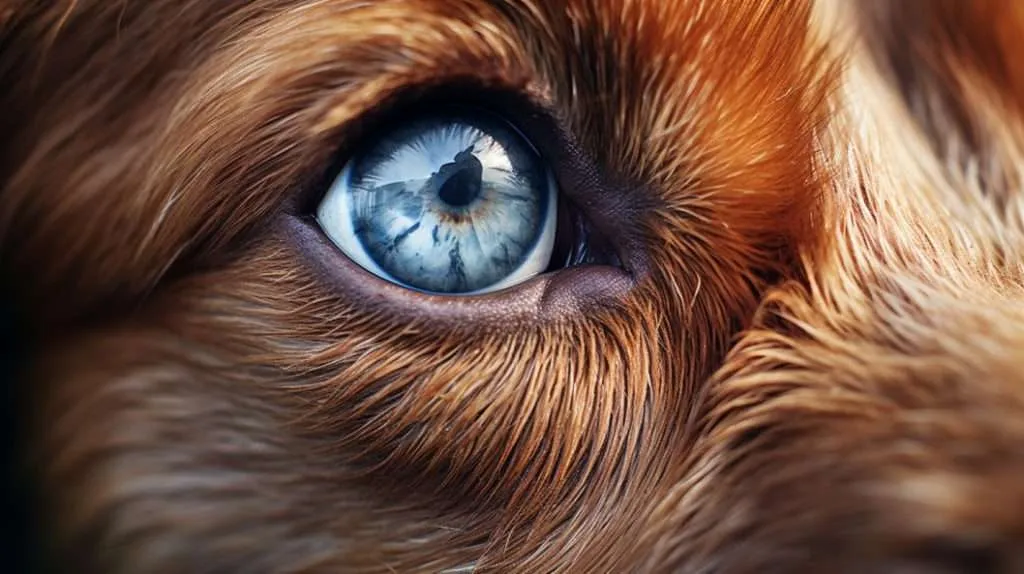
Spotting the telltale signs of cataracts in dogs can be a real eye-opener, leaving pet owners in disbelief at its impact on their furry friend’s vision. To prevent cataracts in dogs, it’s important to maintain their overall health and manage their diabetes effectively. Here are four ways to prevent cataracts in dogs:
- Diet: Feeding your dog a balanced diet rich in antioxidants can help reduce the risk of cataracts.
- Regular exercise: Keeping your dog active and maintaining a healthy weight can lower the chances of developing diabetic cataracts.
- Regular veterinary check-ups: Regular visits to the vet can help catch any early signs of cataracts and manage diabetes effectively.
- Alternative treatments: Some natural supplements, such as lutein and zeaxanthin, have shown potential in preventing cataracts in dogs.
Taking these preventative measures can help protect your dog from developing cataracts and preserve their vision. Moving on to diagnosing cataracts and diabetes in dogs…
Diagnosing Cataracts and Diabetes in Dogs
Take a moment to witness the profound impact that cataracts and diabetes can have on your beloved canine companion. The progression of cataracts in dogs with diabetes differs from that in non-diabetic dogs. While cataracts typically develop slowly over time in non-diabetic dogs, they tend to progress more rapidly in diabetic dogs. This is due to the high glucose levels in the eye’s lens, which leads to accelerated clouding.
Recognizing the symptoms and getting a proper diagnosis is crucial for early intervention. If your dog is diagnosed with diabetes and cataracts, alternative treatment options are available. These include medications, such as eye drops or oral antioxidants, which can help slow down the progression of cataracts. Stay tuned to learn more about the treatment options for diabetic dogs with cataracts.
Treatment Options for Diabetic Dogs with Cataracts
Now that you understand how cataracts and diabetes are diagnosed in dogs let’s explore the treatment options available for diabetic dogs with cataracts.
While surgery is the most common and effective treatment for cataracts in dogs, there are non-surgical alternatives and alternative therapies that may be considered, depending on the severity of the cataracts and the dog’s overall health.
Non-surgical alternatives include using eye drops and medications to manage the symptoms and slow the progression of diabetic cataracts. Additionally, alternative treatments such as antioxidants and nutritional supplements may be recommended to support the overall eye health of the diabetic dog. However, it’s important to note that these alternative options may not completely reverse the cataracts.
In cases where cataracts significantly impair the dog’s vision or cause discomfort, surgical intervention may be necessary. This will be discussed in the subsequent section.
Surgical Intervention for Cataracts in Dogs
Surgical intervention is the ultimate game-changer for diabetic dogs with cataracts, offering a remarkable chance to restore their eyesight and transform their lives.
Several surgical techniques are available to treat cataracts in dogs, including phacoemulsification and extracapsular extraction. Phacoemulsification involves using ultrasound waves to break up the cataract into tiny pieces, which are then suctioned out of the eye. Extracapsular extraction, on the other hand, involves removing the entire lens and the cataract through a larger incision.
Following surgery, post-operative care is crucial to ensure a successful outcome. This may include administering eye drops to prevent infection and inflammation, monitoring the dog’s activity level to avoid complications, and scheduling regular follow-up appointments with the veterinarian.
Managing diabetes to prevent cataracts is the next important step in maintaining the dog’s health and well-being.
Managing Diabetes to Prevent Cataracts
To effectively manage diabetes and prevent the development of cataracts in dogs, it’s crucial to maintain a consistent and balanced diet, monitor blood sugar levels regularly, and administer prescribed medications as directed.
Managing diabetes through diet involves feeding your dog high-quality, low-carbohydrate food specifically formulated for diabetic pets. This helps regulate blood sugar levels and prevent spikes contributing to cataract formation.
Additionally, regular exercise is essential to prevent cataracts in dogs with diabetes. Exercise helps improve insulin sensitivity, which aids in blood sugar control and reduces the risk of cataracts. Engage your dog in daily activities such as walks, playtime, or interactive toys to promote physical activity.
By managing diabetes through diet and preventing cataracts through exercise, you can help ensure your furry companion’s overall well-being.
Moving on to lifestyle adjustments for dogs with cataracts, it’s important to make certain adaptations to enhance their quality of life.
Lifestyle Adjustments for Dogs with Cataracts
Making lifestyle adjustments for dogs with cataracts involves creating a safe and navigable environment, such as removing obstacles and providing ramps or stairs to help them move around easily. Here are four important lifestyle modifications that can greatly improve the quality of life for dogs with cataracts:
- Ensure a well-lit environment: Increased lighting can help compensate for the impaired vision caused by cataracts. Use brighter light bulbs and consider adding additional lighting sources to improve visibility for your furry friend.
- Adapt their diet: Consult with your veterinarian to determine if any dietary adjustments are necessary. Certain nutrients like antioxidants and omega-3 fatty acids may positively impact eye health and slow the progression of cataracts.
- Regular exercise: Encourage moderate exercise to keep your dog physically active and mentally stimulated. This can help maintain muscle tone and prevent weight gain, which can aggravate the effects of cataracts.
- Maintain routine and consistency: Dogs rely on routine and familiarity, especially when dealing with vision loss. Stick to a consistent schedule for meals, walks, and playtime to provide a sense of security and stability.
By implementing these lifestyle modifications and providing the necessary support, you can help your dog adjust to life with cataracts. Moving forward, let’s explore the emotional impact of blindness in dogs.
The Emotional Impact of Blindness on Dogs
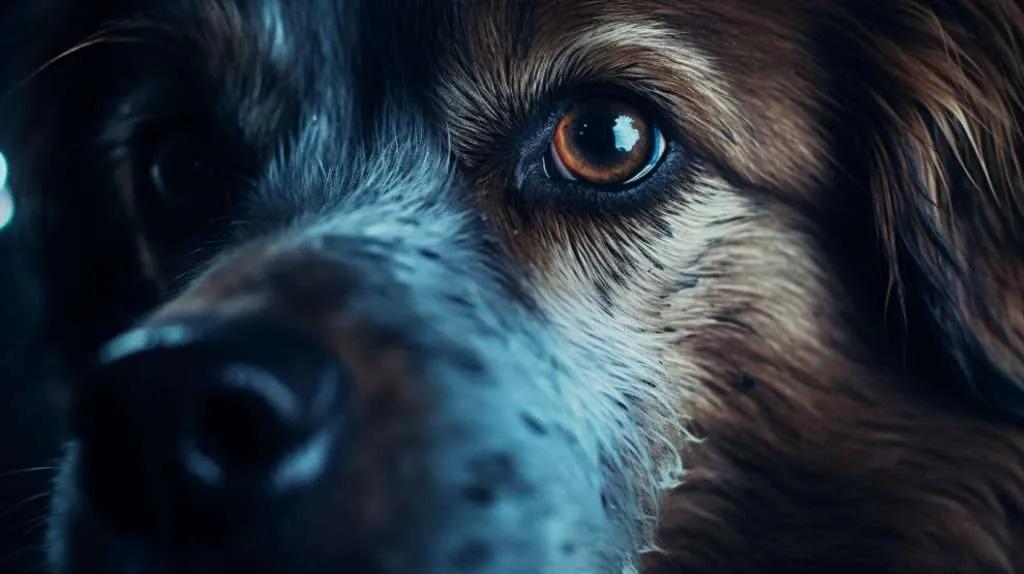
The emotional toll of vision loss can be overwhelming for our furry companions, as they may experience feelings of confusion and frustration due to their impaired sight. The impact of blindness on dogs is significant, affecting their daily lives and overall well-being. To better understand the emotional challenges faced by blind dogs, let’s take a closer look at a comparison between their experiences before and after vision loss:
| Before Vision Loss | After Vision Loss |
|---|---|
| Confident and independent | Dependent on their owners |
| Eager to explore surroundings | Hesitant and cautious |
| Responsive to visual cues | Reliant on other senses |
| Engaged in visual play | Limited in play options |
| Social and outgoing | Less confident in social situations |
Support for blind dogs is crucial to help them adapt and thrive. Providing a safe and predictable environment, using verbal cues and touch for communication, and introducing sensory enrichment activities can all help alleviate the emotional impact of blindness. Transitioning to the next section about preventive measures and regular eye exams for canine health, it is important to be proactive in maintaining the well-being of our furry friends.
Preventive Measures and Regular Eye Exams for Canine Health
Ensure your furry companion’s well-being by taking proactive measures and scheduling regular eye exams to maintain their overall health.
Preventive measures play a crucial role in preserving your canine’s eye health. Start by keeping their eyes clean and free from debris or irritants. Regularly inspect their eyes for any signs of redness, swelling, or discharge, which could indicate an underlying issue.
Additionally, provide a balanced diet rich in vitamins and antioxidants to support their ocular health. Avoid exposing your dog to harmful UV rays by limiting their time in direct sunlight or using canine-specific sunglasses.
Lastly, make it a priority to schedule routine eye exams with a veterinary ophthalmologist. These exams can detect early signs of cataracts, glaucoma, or other eye conditions, allowing for timely intervention and treatment.
Implementing these preventive measures and maintaining regular eye exams can help safeguard your furry friend’s visual health and ensure their overall well-being.
Frequently Asked Questions
Can cataracts in dogs be treated without surgery?
Non-surgical options and natural remedies can help manage cataracts in dogs but cannot eliminate them. These alternatives, such as eye drops and supplements, may slow the progression of cataracts and improve vision to some extent.
Are there any alternative treatments for diabetic dogs with cataracts?
Yes, alternative therapies and natural remedies are available for diabetic dogs with cataracts. These treatments, such as antioxidant supplements and herbal eye drops, can help slow down the progression of cataracts and improve overall eye health.
How common are cataracts in dogs with diabetes?
Cataracts in dogs with diabetes are relatively common, with a prevalence of around 75%. Risk factors include age, duration of diabetes, and the level of glucose control. Regular eye examinations are crucial to detect and manage this condition.
Can diabetes in dogs be prevented to avoid cataract development?
To prevent cataract development in dogs with diabetes, you can implement prevention strategies such as regular exercise, maintaining a healthy weight, and providing a balanced diet with appropriate dietary interventions.
How often should a dog with cataracts and diabetes have regular eye exams?
For dogs with cataracts and diabetes, it is recommended to have regular eye exams every 6-12 months. These exams are crucial in monitoring the progression of cataracts and assessing the overall eye health of the dog.
Conclusion
Congratulations on completing the journey through the world of canine cataracts and diabetes. By unraveling the intricate anatomy of a dog’s eye and understanding how cataracts form, you have gained a deeper insight into this shocking link. Recognizing the crucial role of diabetes, you can now take proactive steps to manage your dog’s diabetes and prevent the onset of cataracts. Regular eye exams and preventive measures are key to ensuring your furry friend’s long-lasting ocular health.
Together, let’s navigate the path toward a brighter, clearer future for our beloved canine companions.
Reader Advisory: This article, aimed at informational purposes, does not replace professional veterinary advice. While we aim for accuracy, we make no guarantees regarding the completeness or reliability of our content. Always consult a veterinarian before altering your dog’s diet or nutrition.




